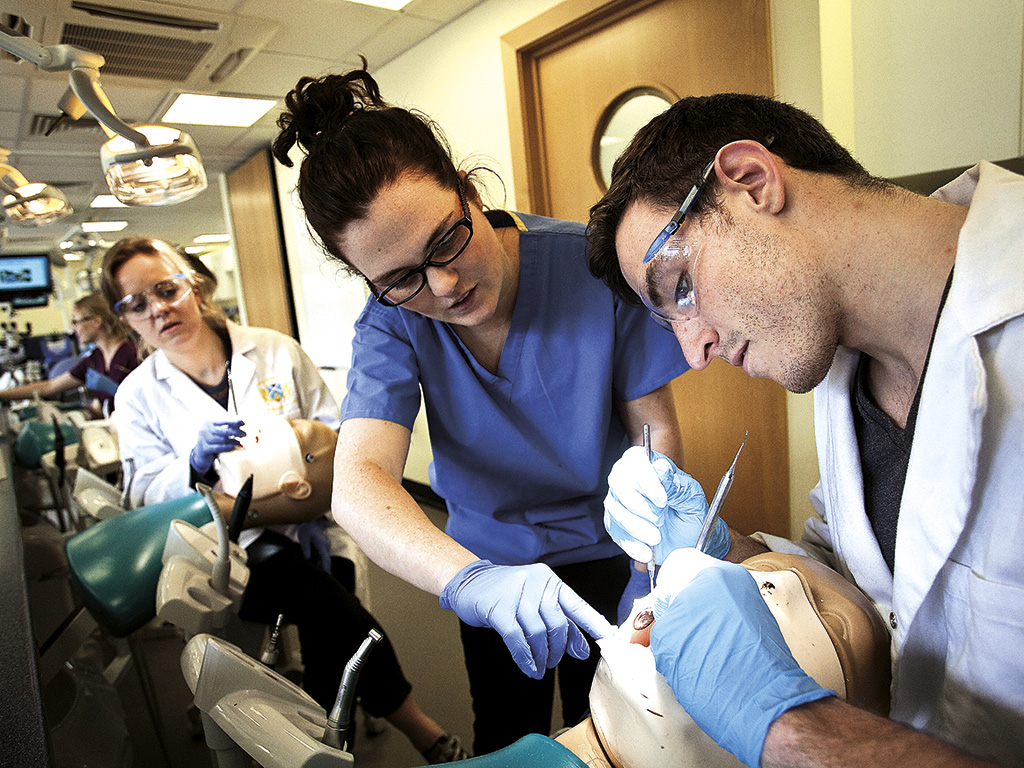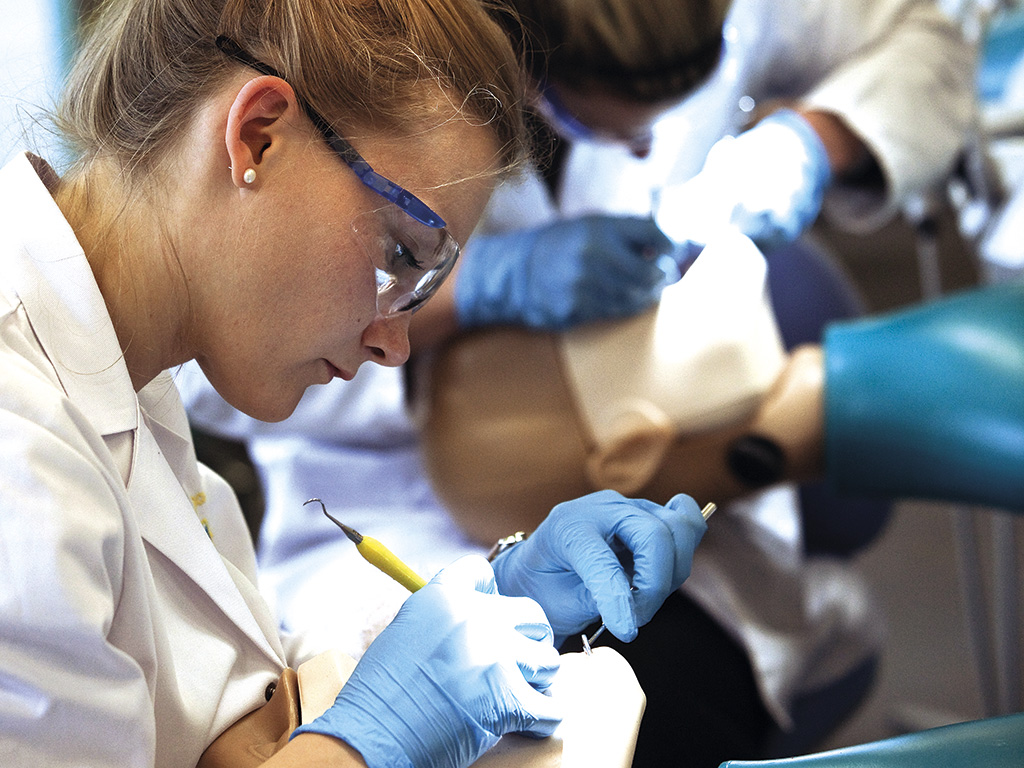Taking the lead with canine teeth
Veterinary students are learning vital dentistry skills in An innovative ‘hands-on’ project at the Edinburgh Dental institute
As usual, the ‘phantom head’ lab of the Edinburgh Dental Institute is full of young students, decked out in pristine white lab coats and protective glasses, studiously cleaning the red paint from the teeth of rows of grinning dental mannequins. The atmosphere is one of quiet concentration with only the gentle background hum of ultrasonic scalers to be heard as the young people get to grips with the techniques of scaling and polishing.
The only thing different on this particular day in late April, compared to others, is that these are not dental students – they are young vets from the Royal (Dick) School of Veterinary Studies. They are here to learn ‘human’ dental prophylaxis techniques that they will be able to use on the animals they will care for in the future as qualified veterinarians.
While the morphology of animal teeth is different from humans, the diseases that affect the teeth and gums of both species are very similar and, therefore, many of the basic techniques in dealing with them are transferable from dental practitioners to veterinary surgeons.
I know of no school that has a full-time vet dental specialist on their staff
Andrew Gardiner, senior vet lecturer
Dental and gum disease is the most common clinical condition in dogs and cats presenting to vets. It is estimated that up to 80 per cent of dogs and 70 per cent of cats over three years old are affected to some extent, and that without treatment, this will result in painful conditions and, ultimately, loss of teeth.
It’s also a problem for some livestock, particularly horses, so Andrew Gardiner, senior vet lecturer at the Royal (Dick) School of Veterinary Studies, decided it was important that his students get more experience of dealing with these conditions.
He said: “I believe that dentistry could be taught more in veterinary schools today, as I know of no school that has a full-time vet dental specialist on their staff. It is often taught by visiting specialist veterinary dentists, but there is a strong argument for providing more practical training.”
One of Andrew’s roles at the Vet School is to develop the educational content of the courses with respect to ‘day one competencies’ for general practice, and a fortuitous meeting between Professor Susan Rhind, deputy head of school – teaching, and the Edinburgh Dental Institute’s director Angus Walls brought up the idea of collaborating on dental techniques.
This led to a pilot project last year where the Institute provided a two-day course for 23 fourth-year vet students (the veterinary degree is a five-year course), which included theory lectures and practical work in its state-of-the-art ‘phantom head’ dental teaching lab.
The theory provided the students with an overview of gingivitis and periodontitis, the nature of biofilm and calculus, and periodontal assessment. The practical session in the lab gave them hands-on experience of using the different types of hand scaling equipment, the principals of prophylaxis and the techniques of using the three most common types of mechanical scaling equipment, including sonic and ultrasonics.
Joanne MacLeod, Lecturer in Oral Health Sciences at the Edinburgh Dental Institute, helped organise the pilot programme last May, and said the feedback from students was positive: “A lot of the students appreciated the practical aspect of the course and by the end, all said they had significantly increased their confidence in not only hand and mechanical scaling techniques but also in assessing periodontal health.
“Animals suffer from the same problems as humans when it comes to dental health, so the principals of treating the diseases are virtually the same. So many pets suffer from this condition and often, by the time the owner decides to seek help from a vet, the disease is quite well developed, requiring quite heavy descaling of calculus and even extractions.
“Dealing with dental problems is quite routine for vets – it’s their bread and butter – so it’s important that students learn best practice in these techniques before they start their professional life.”
Following the success of the pilot, another session of teaching was instigated this year for third-year students to give them hands-on experience before they started their job placements in the summer.
Joanne provided the theory lesson at the Vet School in February and then invited 151 students to the lab over four afternoons during the week that the Institute’s hygiene and therapy students were on study leave.
“Of course, this is a short intensive course for them, but the students get valuable practical experience to understand the techniques using the different instruments that they can’t get from just reading about the theory,” added Joanne.
By contrast, undergraduate hygiene and therapy students on the BSc (Hons) Oral Health Sciences degree would have to undertake approximately 110 hours of tutor-led teaching in the lab before they would be allowed to work on a human patient.
In a veterinary surgery, an animal undergoing dental treatment is placed on an operating table on its side, anaesthetised and intubated, while a throat pack is placed in the back of the mouth to stop any material entering the trachea and oesophagus. Other precautions to protect the airway are taken, such as slightly tilting the operating table to put the animal in a head down position, which improves drainage from the mouth.
If a long procedure is expected, the animal will be placed on an intravenous fluid drip, and steps taken to ensure he or she is kept warm during the procedure, as open mouths and lots of irrigation with fluids can lead to significant heat loss in animal patients, especially very small ones.
Andrew said the use of the Institute’s dental lab provides invaluable practical experience for the students. He said: “We have an extensive clinical skills lab at the Vet School, but vet dental mannequins are not generally available. Students practice basic techniques on simple low-fidelity models, such as one developed using a ceramic tile, before coming down to the Dental Institute.
“The opportunity to practise on the Institute’s high-fidelity phantom human heads gives them the appreciation of the techniques and instruments used in prophylaxis and allows them to develop core skills in dental health under professional supervision without endangering a patient.”
Hannah Mason, a student from England, found the experience very useful. She said: “It takes a while to get used to holding the instruments and what pressure to use, but you pick it up quite quickly. I think the big benefit is the experience of working in three dimensions and getting used to the idea of the space you have to work in within the mouth.”
The application of pressure is very important when cleaning animal teeth, as cats and dogs have thinner enamel than humans. Cats’ teeth are much smaller and more fragile than dogs’ and therefore need even more careful treatment.
Chiew Ng from Malaysia has worked in a few vet surgeries on placements in her home country, but has only used hand instruments for scaling. She said: “It’s really good to get to use a selection of the ultrasonic tools that I’ve not used before. This is good experience that will help me become more competent in dental health, and I’m hoping I will be able to practise these techniques in my next placement in the summer.”
Kate Laine, from the US, said she was “pretty excited” about the opportunity to get dental experience in oral health. She said: “It’s a common issue with pets and it’s something vets are now promoting to their clients so they can think about the dental hygiene of their pets and understand the preventative measures they can take.
“It’s not something many pet owners think about, but it can have a huge impact on the long-term welfare of their animals. Owners can even use special toothbrushes that go on the end of a finger to clean their animal’s teeth – it’s a great thing to do and my dog loves it.”
Andrew pointed out that providing good dental health for animals is very rewarding for a vet. He explained: “Often the animal will arrive in chronic pain, but this resolves quickly after treatment. Extractions are common in veterinary dentistry and if the owner then starts brushing using veterinary-specific toothpaste (usually beef or chicken flavoured!), further disease can be prevented.”
Dental work on animals is not restricted to scaling, polishing and extractions, as fillings and root canal treatment are also applicable, although these would normally be carried out by a vet dental specialist.
While cats have very sharp cutting teeth, dogs, like humans, have some flatter ‘grinding’ molars at the back of the mouth and these can be affected by caries as sugars pool on the flattish surfaces – although caries are generally far less common in dogs than in people. When they occur, and provided they are not too advanced, caries can be drilled and filled in the same way as humans.
This is also the case with root canal treatment, particularly where a dog has chipped or broken an important tooth, such as an canine, in order to keep the tooth in position rather than extract it.
Student Elle McKay, from Germany, said the experience at the Institute gave her greater appreciation of dental health. She said: “The scaling is very fiddly. You have to be careful how you hold the instruments and be aware of the best angle to come into the mouth from. It makes me feel very clumsy, but I’ve certainly got a new-found respect for my dentist now!”
Did you know?
The build up of calculus is different between humans and dogs due the location of the main salivary glands, the saliva mineralising the build up of plaque. The main glands in a dog are at the back, contributing plaque build up on the upper back teeth, while the main saliva glands in humans are under the tongue, creating formation of material on the back of the lower front teeth.
Signs that dogs or cats are suffering poor oral health:
• Bad breath
• ‘Jaw chattering’
• Not eating
• Drooling
• Change in mood
• Bleeding from gums
• Calculus/plaque
• Fractured teeth
• Swellings in gums
• Pawing at the mouth





Comments are closed here.